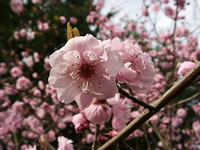How to Grow and Care for Flowering Plum TreesPrunus blireianaFlowering Plums are small deciduous trees that will grow to a height of 15-20 feet, with a 15 foot spread. They belong to the genus of plants that includes cherries, plums, apricots, peaches, nectarines and almonds. They produce an abundance of fragrant, one inch pink flowers in early spring followed later by dark purple foliage that turns light green by mid-summer. The foliage changes back to a deep reddish-purple in the fall. Because they flower so early in the spring, Flowering Plum trees will seldom produce fruit due to a lack of pollinators at blooming time. However, the small,dark purple plums are edible and tasty. |
||
|
||
|
||
Search The Garden Helper:
